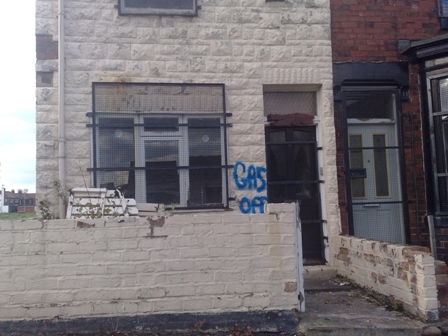
Image – Street protests: an endemic feature of Indian cities. Here, a police officer charges on a group of Maharashtra Navnirman Sena (MNS) party workers in Mumbai October 21, 2008. Police in Maharashtra arrested MNS chief Raj Thackeray on Tuesday after attacks on migrant workers, sparking violent protests and the shutting of some businesses in the financial hub of Mumbai. REUTERS/Punit Paranjpe (INDIA)
by Anindita Ghosh (History)
The city as a valid category of cultural investigation, planning and policy making has made a fairly recent debut in South Asia. It was the village that dominated the imagination of ideologues, academics and artists on the one hand, and planners and politicians on the other, until about the 1960s, when the Nehruvian vision gradually began to take its hold of modern India. As the focus changed, with cities emerging as the nerve-centres of the new democratic India, politics and citizenship came to be defined increasingly in competitive urban languages of belonging and rights, and collective public displays. Of course, there are antecedents within the nationalist period when mass movements such as strikes, picketing, marches, and even riots paralysed the colonial government in major Indian cities. Recent research has highlighted the connections between political populism and aggressive posturing and shown how the visual and performative aspects of popular culture have co-constituted political programmes in both historical and contemporary India.
Urban space is not just what is produced by planning, architecture and landscaping, it is also a social product, the end result of a series of negotiations between the state and its people. The post-1857 moment of British entry into town-planning in colonial India was to exercise social control, whereby civic planning was a ruse to re-establish order – through public architecture, sanitary regimes, and regulation of communication networks. It was to discipline a rebellious population into silence and complicity. But such programmes were fraught from the very start. In Bombay, many aspects of civic reform remained unimplemented due to fears of political repercussions. My own research on colonial Calcutta shows how there prevailed an on-going war between the residents of the city and the municipality over disposal of privy waste (1). The urban visions of technocrats and planners have been historically thwarted in South Asia by those very people against whom these ideas were aimed.
In its milder form opposition from discontented citizens can be represented by passive resistance of urban planning laws. At its extreme it can also metamorphose into spectacular displays of discontent against the administration or establishment. When a bust of B.R. Ambedkar (hero of Dalits or untouchable castes) in front of a medical college in Bangalore was vandalized in 1995, the state of Karnataka went under a violent siege for ten days with Dalit protestors targeting state property, burning buses and obstructing road and rail (2). Such collective enactments in public spaces allow a range of possibilities for self-definition through permanent and/or temporary occupations of city space in languages that are increasingly violent in South Asia. They re-territorialize cities and redefine public life in ways that challenge existing social and political leaderships, and unleash struggles over entitlements to space in the city in the political language of citizenship and rights. The massive response to the perceived insult of a symbol of caste assertion in this case, underlined the emergence of Dalits as rival political power pockets in the state. Newer communities can thus gain sudden and violent visibility through concerted public display, indicative in turn of the changing constituencies claiming access to the urban public sphere.
The city as a site of new and intensified forms of violence in India, and caste and communal violence in particular, has transformed the political scene in contemporary South Asia. Mass action in colonial India was usually orchestrated by political and union leaders, where loyalties and actions of the mobbing crowd could be in theory regulated by ties to local patron figures. But this changed rapidly. Styles of mobilisation of urban groups were forged later on that departed from those of nationalist and left-wing struggles. From more recent times, Thomas Blom Hansen has shown, in the context of radicalisation of religious and ethnic communities in Mumbai in the early 1990s, how radically newer possibilities of self-definition are offered by the urban-industrial settings of towns and cities in South Asia that are different from the loosely ideological and paternalistic modes of previous times. Taking urban violence as his starting point, Hansen shows how urban identities mobilize ethnicity and masculinity in the process of refashioning forms of assertion and notions of citizenship itself (3).
There are undoubtedly lessons to be learnt from the bloody aftermath of the Babri Masjid demolition, the aggressive rallying of Hindu activists in Gujarat and Maharashtra, and the repeated terrorist assaults on Mumbai. But perhaps the South Asian city itself – with its unique mixed rural-urban morphology, strong ties of caste and community, and tremendous technological possibilities – lends itself to such stupefying anarchic moments. As Hansen notes again, The ‘assertive, often violent mode of being urban’ is a sign of a ‘full-blooded plebeian engagement with modern city life and its technologies of power’ (4). South Asian urban societies seem to be built out of an endless chain of chaos and order. Violence has become a way of life, almost a rite of passage for the emergence of newer political constituencies in the region as the sub-continent enters the twenty-first century.
1: ‘Calcutta: Scandals, Death and Crime in a Colonial City, c. 1850-1920’, monograph being prepared for publication.
2: Janaki Nair, The Promise of the Metropolis: Bangalore’s Twentieth Century (New Delhi: Oxford University Press, 2005) pp. 287-90.
3: Thomas Blom Hansen, Urban Violence in India: Identity Politics, Mumbai and the Postcolonial City (Delhi: Permanent Black, 2001).
4: Thomas Blom Hansen, Urban Violence in India, p. 9





